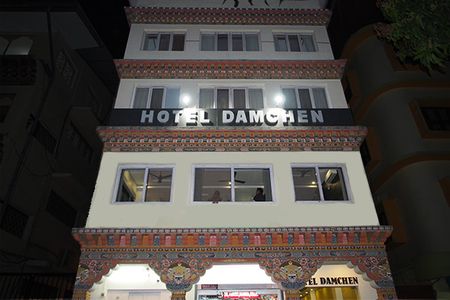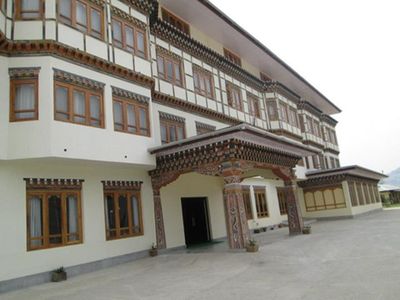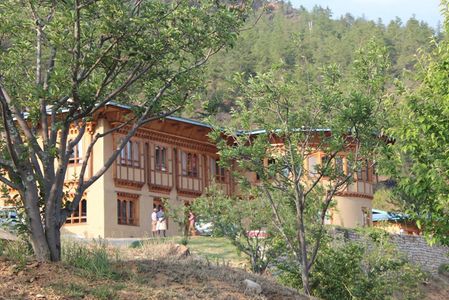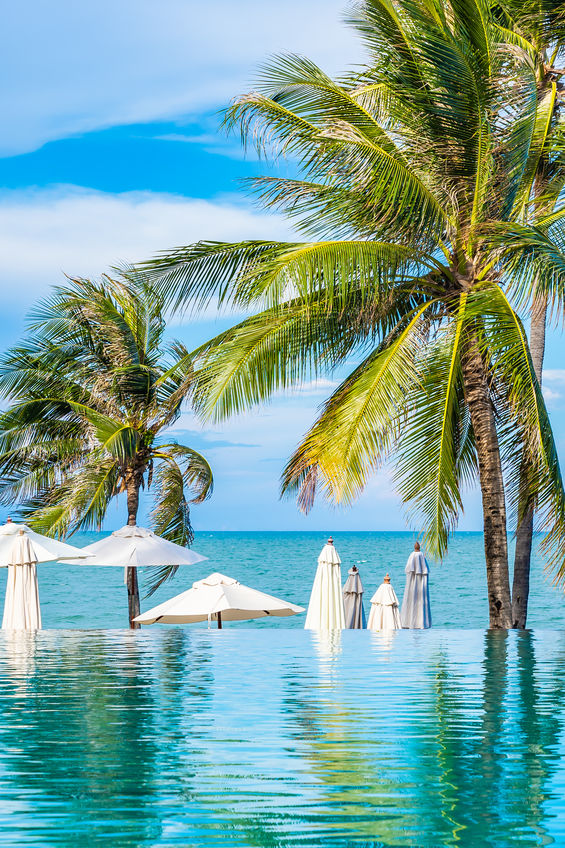
About the trip
Bhutan which is a tiny landlocked nation in East Asia is situated completely within the Himalayan range. Nepal lies to the west of Bhutan and its other close neighbours are Bangladesh and Myanmar. The country of Bhutan is also fondly called ‘The Land of Happiness’ because according to a recent survey, it was concluded that the people of Bhutan are the happiest people living on earth. Bhutan is a truly vibrant, hospitable, colourful and a mesmerising country to visit.
Accommodation

Hotel Damchen
1 nights in Phuntsholing

Hotel Riverside
2 nights in Thimphu

Hotel Pema Karpo
1 nights in Punakha

Rema Resort
2 nights in Paro
Included in the price
Phuntsholing
- Transfer from Bagdogra (IXB) Airport / NJP Railway Station to Phuentsholing - Hyundai Santa Fe / Toyota Innova / Nissan Terrano
- Transfer from Phuentsholing to Thimphu - Hyundai Santa Fe / Toyota Innova / Nissan Terrano
Thimphu
- Full Day Thimphu Sightseeing - Hyundai Santa Fe / Toyota Innova / Nissan Terrano
- Transfer from Thimphu to Punakha/Wangdue & Punkha/Wangdue Sightseeing - Hyundai Santa Fe / Toyota Innova / Nissan Terrano
Punakha
- Transfer from Punakha/ Wangdue With Visit to Royal Botanical Garden + Paro Sightseeing (With Guide) - Jumbo Hiace Van
Paro
- Day Excursion to Haa Valley (With Guide) - Hyundai Santa Fe / Toyota Innova / Nissan Terrano
- Transfer to Paro Airport (With Guide) - Hyundai Santa Fe / Toyota Innova / Nissan Terrano
Phuntsholing
- Transfer from Bagdogra (IXB) Airport / NJP Railway Station to Phuentsholing - Hyundai Santa Fe / Toyota Innova / Nissan Terrano
- Transfer from Phuentsholing to Thimphu - Hyundai Santa Fe / Toyota Innova / Nissan Terrano
Thimphu
- Full Day Thimphu Sightseeing - Hyundai Santa Fe / Toyota Innova / Nissan Terrano
- Transfer from Thimphu to Punakha/Wangdue & Punkha/Wangdue Sightseeing - Hyundai Santa Fe / Toyota Innova / Nissan Terrano
Punakha
- Transfer from Punakha/ Wangdue With Visit to Royal Botanical Garden + Paro Sightseeing (With Guide) - Jumbo Hiace Van
Paro
- Day Excursion to Haa Valley (With Guide) - Hyundai Santa Fe / Toyota Innova / Nissan Terrano
- Transfer to Paro Airport (With Guide) - Hyundai Santa Fe / Toyota Innova / Nissan Terrano
Day-wise Itinerary
ExpandDay 1: Arrival At Bagdogra (Ixb) Airport / Njp Railway Station And Transfer To Phuentsholing
- Meet & Greet on arrival at NJP Railway Station / IXB Airport and transfer to Phuentsholing - The Gateway of Bhutan by Road from India. It is a thriving commercial center on the northern edge of the Indian Plains. On arrival check in at the hotel. Overnight stay at Phuentsholing hotel.
- Depending on your arrival time our representative will assist you in procurement of your permit to Bhutan. The permit issuance takes time depending on the rush one has to stand in queue for procurement of permit. In case the permit is not processed on the day of arrival then it can be issued next day before you start for next destination.
Day 2: Transfer From Phuentsholing To Thimphu
- After breakfast, complete your Visa / Permit formalities assisted by our representative (in case if your permit is not done on arrival day). Our representative will assist you in boarding your vehicle for transfer to Thimphu.
- On arrival check in to the hotel. Overnight stay at Thimphu hotel.
Day 3: Full Day Thimphu Sightseeing
- After breakfasts proceed for full day sightseeing visiting:
- National Memorial Chorten stupa was built in 1974 in the memory of Bhutan's third King, His Late Majesty, King Jigme Dorji Wangchuk, who is popularly regarded as Father of modern Bhutan. The paintings and statues inside the monument provide a deep insight into Buddhist philosophy.
- Tashichho Dzong also know as "fortress of the glorious religion", it was initially built in 1641 and later rebuilt in its present form by King Jigme Dorji Wangchuk in 1965. The Dzong houses, main secretariat building which houses the throne room of His Majesty, the King of Bhutan. The National Assembly Hall is housed in a modern building on the other side of the river from the Dzong. During the warmer summer months, the monk body headed by His Holiness, the Je Khenpo, makes its home in the Dzong.
- Buddha Point (Kuensel Phodrang) is located at a short drive from Thimphu city centre, visitors can get a good overview of the Thimphu valley from the Buddha point (Kuensel Phodrang). You can pay your obeisance and offer prayers to the Buddha, the largest statue in the country and then walk around and take a glimpse of the valley.
- Changangkha Lhakhang is a fortress like temple and monastic school perched on a ridge above Thimphu, south of Motithang. The temple was established in 12th century on a site chosen by Lama Phajo Drugom Shigpo, who came from Tibet. The central statue here is Chenrezig in a manifestation with 11 heads. From temple courtyard, there is fascinating view of Thimphu valley.
- Motithang Takin Preserve located in the Motithang district of Thimphu, Bhutan is a wildlife reserve area for takin, the national animal of Bhutan
- Drubthob Goema/Zilukha Nunnery is perched on a promontory, overlooking picturesque Trashichhoedzong and Golf course, it is the only nunnery in capital known as
- Zilukha Anim Dratsang, once belonged to the Drubthob (Realized one) Thang Thong Gyalpo often referred to as The King of the open field (In the early 15th century with his multiple talents he popularly became the Leonardo da Vinci of the Great Himalayas). You may interact here with some of the nuns who have devoted their life to spirituality and Buddhism.
- Institute for Zorig Chusum is commonly known as Arts & Crafts School or Painting School, the Institute offers a six-year course on the 13 traditional arts and crafts of Bhutan. On a visit, one can see students learning the various skills taught at the school (Closed on Saturday , Sunday, National Holiday & During Summer & Winter Vacations).
- National Textile Museum was opened under the patronage of Her Majesty the Queen Ashi Sangay Choden, Bhutanese textile have reached new heights as one of the most visible distinct art form. The textile museum has opened its exhibition on six major themes - warp pattern weaves, weft pattern weaves, role of textiles in religion, achievements in textile arts, textiles from indigenous fibers and the royal collection. The crowns of Bhutan's Kings, namzas (dresses), the first version of Royal Crown and other accessories used by members of Royal family can be found in the museum. The goal of the museum is to gradually become a center for textile studies that will carry out documentation, research and studies on Bhutanese textiles (Closed on Saturday, Sunday & National Holiday).
- Zangthopelri Lhakhang Monastery present structure was built in 1960s and although lacking the charm of many of the older temples, Zangthoo pelri still possesses some impressive murals and art treasures and is worthy of a visit. The site of the temple was a former battle ground, and the temple was constructed there in order to pacify energies.
- Later return to the hotel for overnight stay.
- Charges for all activities and entry to monuments & memorials need to be paid by the customer on direct payment basis.
Day 4: Transfer From Thimphu To Punakha/wangdue & Punakha/wangdue Sightseeing
- After breakfast, drive towards Punakha / Wangdue. On the way stop at Dochu-La-Pass to view the higher Himalayas.
- Dochula Pass is a mountain pass in the snow covered Himalayas within Bhutan on the road from Thimpu to Punakha where 108 memorial chortens or stupas known as "Druk Wangyal Chortens" have been built by Ashi Dorji Wangmo Wangchuk, the eldest Queen Mother. Apart from the chortens there is a monastery called the Druk Wangyal Lhakhang (temple), built in honour of the fourth Druk Gyalpo (head of the state of Bhutan), Jigme Singye Wangchuck. The open grounds in its front yard is a venue for the annual Dochula Druk Wangyel Festival.
- Arrival at Punakha & check in to the hotel. Afterwards, proceed for Punaka/Wangdue sightseeing visiting:
- Punakha Dzong is built strategically at the junction of Pho Chhu and Mo Chhu rivers in 1637, by Shabdrung Ngawang Namgyal to serve as the religious and administrative centre of the region, Punakha Dzong has played an important role in Bhutan's history. Damaged by four catastrophic fires and an earthquake, the Dzong has been fully restored by the present King. The Dzong is open for visitors during Punakha festival and in summer months when the monk body moves to Thimphu.
- Take a short break and easy hike to visit the Chhimi Lhakhang also known as “The Temple of Fertility”
- Chimi Lhakhang situated on a hillock in the centre of the valley, is dedicated to Lama Drukpa Kuenley, who in the late 15th century used humour, songs and outrageous behavior to dramatise his teachings and due to this also known as "Divine Madman". This temple is also known as the temple of fertility. It is widely believed that couples who do not have children and wanting one, if they pray at this temple, they are usually blessed with a child very soon.
- Check in to the Hotel, Evening free for leisure. Overnight stay at Punakha / Wangdue hotel.
- Charges for all activities and entry to monuments & memorials need to be paid by the customer on direct payment basis.
Day 5: Transfer From Punakha/wangdue To Paro With Visit To Royal Botanical Garden + Paro Sightseeing
- After breakfast transfer to Paro. Enroute Stop at Lamperi to visit Royal Botanical Garden.
- The Royal Botanical Park, Lampelri is the first botanic park in Asian country and forms the scenery of the Dochula Pass. The park has a lake referred to as Baritsho Lake which has spiritual quality because the native folks provide dedicated offerings. There are trekking routes or trails such as the shrub walk (1 km), Serchu Nature Trail (1 km), Dochula Nature Trail (1.5 km), Lumitsawa Ancient path (4.7 km), Lungchu Tshey Pilgrimage (3.5 km), and the Thadna Jungle Walk (125 km).
- On arrival check in at the hotel and proceed to local sightseeing visiting:
- Ta Dzong is a one time watch tower built to defend Rinpung Dozng during inter-valley wars of the 17th century, since 1967 Ta Dzong is serving as the National Museum of the country. It holds fascinating collection of art, relics, religious thangkha paintings and Bhutan's exquisite postage stamps. The museum circular shape augments its varied collection displayed over several floors.
- Rinpung Dzong was Built in 1646 by Shabdrung Ngawang Namgyal , the first spiritual and temporal ruler of Bhutan, the Dzong houses the monastic body of Paro, the office of the Dzongda (district administrative head) and Thrimpon (judge) of Paro district. The approach to the Dzong is through a traditional covered bridge called Nemi Zam. A walk through the bridge, over a stone inlaid path, offers a good view of the architectural wonder of the Dzong as well as life around it. It is also the venue of Paro Tshechu, held once a year in the spring.
- Evening free for leisure. Overnight stay at Paro hotel.
Day Excursion To Haa Valley
- Start the day early for a full day excursion to Haa via Chele-la pass with packed or early breakfast (subjected to availability).
- Haa Dzong located in Haa Valley was built in 1895 because a pressing need was felt to protect the adjoining border from Tibetan invasions and after the appointment of the first Haa Drungpa, it became necessary to build an administrative center. The dzong caught fire in 1913 but the destruction was so severe that a new dzong had to be erected. In 1963, the dzong was turned over to the Indian army to be used as a camp. In 1968 a new dzong was again constructed and it continues to function as the district administrative headquarters.
- Lhakhang Karpo holds the oldest paintings at Tsaparang and is probably the most important chapel in all of Ngari. The murals date back to the 15th or 16th century but their influences extend back to 10th-century Kashmiri Buddhist art. The ceiling of the chapel is beautifully painted, as are the many thin supporting columns made from composite pieces of wood (trees are scarcer than hen’s teeth in Ngari). The doors are flanked by two damaged 5m-high guardian figures, red Tamdrin (Hayagriva) and blue Chana Dorje (Vajrapani). Even armless they hint at the lost marvels of the chapel. The huge figure of Sakyamuni that once stood in the recess, the Jowo Khang, at the back of the hall has been replaced by one of the caretaker’s statues.
- Lhakhang Nagpo (Black Chapel), one of the oldest temples in the valley. It is said that when searching out auspicious locations for two new temples the Tibetan king
- Songtsen Gampo released one black pigeon and one white pigeon; the black pigeon landed here, the white one at Lhakhang Kharpo (White Chapel). The inner shrine has an ancient statue of Jowo Sakyamuni wearing a lovely crown and jewels. The outer chapel houses a shrine to red-faced protector Drakdu Tsen beside a trap door that leads to the underground pool of a tshomen (mermaid spirit). In the grounds outside look for the clay representations of the valley's three sacred mountains.
- Wangchulo Dzong is one of the newer dzongs having been constructed in 1913. Rather uniquely, Wangchulo Dzong is located inside the IMTRAT compound (Indian Military Training Team) camp and a Bhutanese army training camp.
- Evening you drive back to Paro for overnight stay at the hotel.
- Depending on the weather, Road conditions and time Haa excursion could be either taken from Chele-la Pass or from Chozum side.
Day 7: Departure From Paro To Paro Airport
After breakfast, check out from hotel and drop at Paro Airport for your onward journey.

